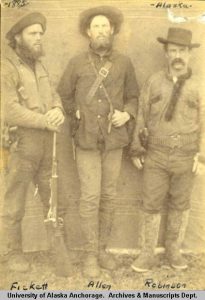As an archivist I am often asked “what does someone use an archive for?” The question may seem easy to answer—many assume that most users of archives are scholars or historians. But researcher questions vary with each researcher who walks through the door, calls us on the phone, or sends us an email. People use archives for a variety of reasons, either for personal interests, to feel connected with loved ones, research for work, digging up dirt on an individual, information for a reality TV show, dissertations…. The list goes on. Below are some of the more memorable or notable requests we have received at Archives and Special Collections.
A woman found her father’s name listed in our online finding aids for a conference presentation he gave at UAA. She requested an audio recording of the presentation and later told us that her father had passed away. She just wanted to hear the sound of his voice.
Another woman came in because she wanted to see her mom’s name written somewhere. We searched through various collections (her mother was a former UAA employee), and as soon as she saw her mother’s name listed in a phone directory, she was happy—it was all she needed to see. She just wanted that connection.
A gentleman visited the Archives and wanted copies of various brochures that had his wife’s name listed. She had passed away a few years before.
A woman was given up for adoption when she was a baby and had found the names of her birth parents in a collection at the Archives. She came to Alaska in order to find out more information about them.
Our photographs have been used in various documentaries and featured on reality TV shows, such as Yukon Men, Buying Alaska, and Deadliest Catch.
Our photographs hang on the walls of the Bass Pro Shop and Cabela’s Anchorage stores, as well as numerous hotels, bed and breakfasts, offices, and people’s homes. Images have also been requested as gifts for friends and family members.
Some of our photographs are even featured on interpretative signs at various locations, including a bike trail in Montana, the Glen Alps trailhead, and Castle Hill in Sitka.
People have used our collections (documents and photographs) for research in lawsuits, animal populations, drill site cleanups, aviation, and locating WWII mine placements in the Aleutians.
We have even had researchers come in to look into the backgrounds of candidates running for public office.
Fan clubs, such as the Coleman Stove Company Fan Club and Star Trek, have requested materials from our collections.
Our material has been featured in various exhibits in museums, like the Anchorage Museum, the Shoe Museum in Toronto, UA Museum of the North, the Centers for Disease Control Museum, and the National Museum of Ethnology in Leiden, Netherlands.
Just in the past year, materials have been requested for use in National Park Service reports, a publication for a cruise line, seven documentaries and TV shows, event programs and fliers, books, journal articles, theses and dissertations, interpretive signs in National Parks and museum exhibits, two murals, websites, social media, and office décor.
So you see, when people ask the question “what does someone use an archive for?” it is always hard for me to answer. Sometimes I just want to reply “whatever it is they want.”



